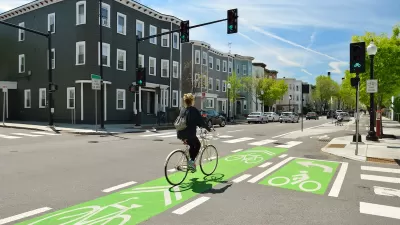A proposed ordinance that would allow neighborhood associations to request removal of bike lanes has sparked a debate over how to prioritize bike and pedestrian infrastructure.

A proposed ordinance regulating bike lanes in Kansas City has sparked a broader debate about "the quality of the city’s streets and sidewalks, about the neighborhoods that are prioritized for improvements and the ones left behind, about equity and whose voices are heard," writes Celisa Calacal.
The ordinance, introduced by Councilwoman Melissa Robinson, drew controversy for its inclusion of language that lets the city remove existing bike lanes at the request of neighborhood associations. The councilwoman says she supports bike lanes, but points to other unmet needs in some of the city's most underserved neighborhoods. According to Robinson, "The deepest socially and economically disadvantaged communities depend on public transit, and their mobility is walking." For her, this signals a need for boosting funding for sidewalk repairs and improvements. But complete streets advocates reject Robinson's framing of bike lanes and sidewalks as priorities in opposition to each other.
While Robinson says the ordinance is meant to respond to resident concerns, Michael Kelley, policy director of BikeWalkNC, notes that the position of neighborhood associations often doesn't include "a whole swath of the community that deserves to have a say in improvements, which will impact their safety." The debate continues as the city moves forward with the ordinance.
FULL STORY: How an ordinance over bike lanes became a flashpoint for conversations about Kansas City infrastructure

Alabama: Trump Terminates Settlements for Black Communities Harmed By Raw Sewage
Trump deemed the landmark civil rights agreement “illegal DEI and environmental justice policy.”

Study: Maui’s Plan to Convert Vacation Rentals to Long-Term Housing Could Cause Nearly $1 Billion Economic Loss
The plan would reduce visitor accommodation by 25% resulting in 1,900 jobs lost.

Planetizen Federal Action Tracker
A weekly monitor of how Trump’s orders and actions are impacting planners and planning in America.

Waymo Gets Permission to Map SF’s Market Street
If allowed to operate on the traffic-restricted street, Waymo’s autonomous taxis would have a leg up over ride-hailing competitors — and counter the city’s efforts to grow bike and pedestrian on the thoroughfare.

Parklet Symposium Highlights the Success of Shared Spaces
Parklets got a boost during the Covid-19 pandemic, when the concept was translated to outdoor dining programs that offered restaurants a lifeline during the shutdown.

Federal Homelessness Agency Places Entire Staff on Leave
The U.S. Interagency Council on Homelessness is the only federal agency dedicated to preventing and ending homelessness.
Urban Design for Planners 1: Software Tools
This six-course series explores essential urban design concepts using open source software and equips planners with the tools they need to participate fully in the urban design process.
Planning for Universal Design
Learn the tools for implementing Universal Design in planning regulations.
Caltrans
Smith Gee Studio
Institute for Housing and Urban Development Studies (IHS)
City of Grandview
Harvard GSD Executive Education
Toledo-Lucas County Plan Commissions
Salt Lake City
NYU Wagner Graduate School of Public Service





























